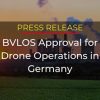With emissions regulation tightening and public awareness of environmental issues growing, the oil and gas industry is under increasing pressure to up the ante when it comes to site inspections. At the same time, there’s the constant need to keep costs down and productivity up. The burning question is HOW?
Relying on what’s worked before is no longer enough. Legacy inspection techniques are labor-intensive, costly, and often put personnel at risk. And while there has been a lot of buzz about oil and gas inspection automation, it isn’t always clear how drones for the oil and gas industry are actually used, or what oil and gas inspection software is needed to enable full automation of both upstream and downstream oil and gas inspection.
To go beyond the buzz and make sense of it all, we’ve put together a list of five key use cases where automated drone inspection excels in meeting pressing challenges facing the oil and gas industry.
OGI Inspections
Oil and gas facilities have hundreds of assets, miles of piping, and thousands of connection points where leaks can occur at any time. Legacy oil and gas pipeline inspection requires a refinery inspection team of several employees and or contractors to cover such a wide range of assets. The inspections are extremely time-consuming, costly, and hazardous for the inspection team. Moreover, they don’t catch all the leaks, as even a large inspection team can’t be everywhere at once.
Autonomous drone inspection and remote ops dramatically reduces the time needed for inspections and offers an improved vantage point that helps detect leaks that would be missed using legacy inspection methods. Utilizing the Percepto OGI system allows facilities to inspect more assets more often, with less personnel, and without putting employees in hazardous situations.
Power Distribution Inspection
Inspecting substation and power distribution systems is expensive, hazardous, and time-consuming. Yet insufficient inspection can lead to large single events and ongoing downtime events that can cost a facility hundreds of thousands, if not millions of dollars.
Oil and gas inspection automation systems like Percepto’s reduce the time needed to conduct these inspections by 50% – 80%, which means that inspections can be conducted more frequently. In addition, the data collected in the inspections can be run through Percepto’s AIM software. This saves the process owner additional time in data review since it pinpoints the actionable insights needed to make smarter business decisions. The analytics also support preventative maintenance, detecting trends that can indicate a potential problem before it happens.
Time isn’t the only thing saved. The costs of traditional inspections and reports range from $50,000 to >$250,000, depending on the size of the facility. Automated drone systems like Percepto’s lower costs dramatically, which also helps support more frequent inspections that allow the site team to find anomalies before they fail, as well as track and trend potential anomalies. In fact, in some plants where the Percepto system is active, power distribution failures have decreased by more than 20%.
Floating Roof Inspection
Heavy rain or storm conditions can sink the floating roof system on above-ground tanks. To prevent this from happening, oil tank inspection staff must inspect the drains frequently. However, these hazardous height inspections are dangerous and time-consuming and therefore are not conducted as frequently as they should be, and subpar inspections often lead to failures.
Percepto’s drone-in-a-box can reduce drain inspection time by 80% – 90%, which means that inspectors can increase their inspection frequency significantly and aren’t exposed to danger in the process. In addition, the inspections can be launched instantly, and the results given to the process owner in real time, enabling smarter, data-driven business decisions, and allowing them to respond to potential failure situations.
Emergency Response
One of the key challenges in emergency situations is getting accurate information to the decision-makers in real time. Inability to do so often leads to poor decision-making and inflated response times that can result in destruction, injuries, or even death.
Percepto’s drone-in-a-box can be remotely launched within minutes when an emergency arises, providing real-time visual, thermal, and gas detection data to the decision-makers and a constant live feed to facility and corporate personnel. When emergency response leaders have instant access to real-time data, they can make faster and better decisions, limit risk to personnel, and reduce potential damage to the facility. In addition, they can easily collaborate with corporate partners through the AIM software.
Flare Stack Inspection
A single flare failure can abruptly halt oil & gas facility operations, leading to production loss and unplanned expenditures, as well as major environmental damage. Yet legacy inspection methods require the flare to be shut down, which also leads to loss.
Drones for the oil and gas industry eliminate the need for plant shutdown with aerial inspections that can be done while the flare remains fully functional. When drones collect data, employees are kept out of harm’s way, and flare inspections take mere hours rather than days or weeks. The inspections, which utilize state-of-the-art thermal analysis software tools, can be conducted more frequently and improve sustainability by ensuring that pollutants aren’t released into the environment.

Advancing to better inspections and smarter data
Those five use cases are all critical areas where automated oil and gas drone inspection can significantly improve performance across every meaningful vector—safety, sustainability and environmental protection, productivity, and efficiency. Other use cases include heater and reactor inspections.
Yet no matter the use case, the need for autonomous monitoring and inspection in the oil and gas industry is clear. Given the tightening global environmental and safety standards, it gives companies a way to “future proof” their facilities and meet the demands of the modern world. And since Percepto has now received the first-ever FAA waiver that allows drones to operate beyond visual line of sight (BVLOS) without costly ground-based DAA systems or humans onsite, oil and gas companies can reap the benefits of remote autonomous operations from day one, without the delays of lengthy regulation approvals.





